How Does Neurofeedback Work? A Scientific Answer
How does neurofeedback work? Discover the science behind it and how it can benefit you. Learn more on our blog.
How Does Neurofeedback Work? Discover the Science Behind It. Understand the science behind neurofeedback and how it can help improve brain function.
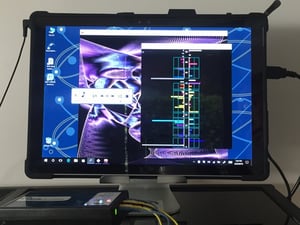 Neurofeedback devices are at the high end of sophisticated when it comes to health and wellness technology. They measure brain activity and uses trailblazing software to interpret brain wave patterns that are then fed back to the individual in real time. There are currently two generations of neurofeedback systems, linear and non-linear, respectively.
Neurofeedback devices are at the high end of sophisticated when it comes to health and wellness technology. They measure brain activity and uses trailblazing software to interpret brain wave patterns that are then fed back to the individual in real time. There are currently two generations of neurofeedback systems, linear and non-linear, respectively.
Neurofeedback machines have been around since the 1960s, but only became the sophisticated devices they are today due to the advancement of computer power and speed. In order to make a brain training tool for the general public, the price of computers had to become affordable; this happened in the 1990s.
The brain communicates through electricity-- measured in Hertz-- and through chemicals called neurotransmitters. Whenever the brain makes a decision, that information manifests as electricity and is sent along the highways of the brain, known as neurons. Neurotransmitters are used to send signals between neurons .
Did you know that the brain has approximately 100 billion neurons that fire approximately 100 times per second? And a signal is sent in .5 milliseconds. It takes sophisticated technology to follow the breadth and speed of communication in the human brain.
What Is Neurofeedback Training?
The good and bad habits of humans appear in their brain's millisecond-by-millisecond electrical activity, commonly known as brainwaves. For example, when we are sleeping, Theta brain waves are dominant. When we are excited or over-stimulated, Beta waves are dominant.
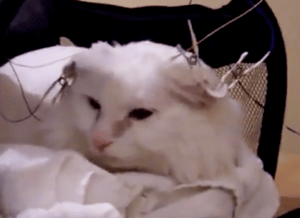 When neurofeedback was still in its infancy, neurologists and neuropsychologists started to understand that measuring brain activity was a meaningful way to track the brain's choices. They also found that giving feedback to the brain about those choices would help improve the brain's functioning.
When neurofeedback was still in its infancy, neurologists and neuropsychologists started to understand that measuring brain activity was a meaningful way to track the brain's choices. They also found that giving feedback to the brain about those choices would help improve the brain's functioning.
The power of neurofeedback was discovered by accident when a UCLA professor, Dr Barry Sterman, was studying the brain waves of cats and found that their brain functioning improved when they had received reinforcements during certain brainwave activity.
Below, we will discuss how these three different neurofeedback machines work and how long do they take to work, as well as their side effects.
Neurofeedback is a process whereby a computing de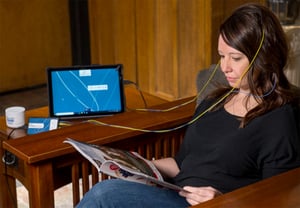 vice gives feedback to an individual brain through auditory and/or visual cues, in order to alert the individual that their brain is experiencing shifts in its electrical activity. The goal is for the brain to learn how to shift out of maladaptive patterns and instead repeat healthy, appropriate and adaptive patterns.
vice gives feedback to an individual brain through auditory and/or visual cues, in order to alert the individual that their brain is experiencing shifts in its electrical activity. The goal is for the brain to learn how to shift out of maladaptive patterns and instead repeat healthy, appropriate and adaptive patterns.
Nurofeedback uses EEG sensors to collect information on electrical activity, as measured on the scalp. This information is fed to an amplifier that changes the electrical voltage into numbers. Those numbers are translated into brain wave frequencies and read by the neurofeedback software. While there is some variance depending on the goals of the neurofeedback device, most softwares look for frequencies that are outside of the normal range.
Linear neurofeedback, which is the first generation if neurofeedback devices, works by first taking a brain map, known as a QEEG. Then, it measures the brainwave frequencies of the trainee's brain and looks for deficits. For example, it may show that the brain is not emitting enough Beta activity.
After identifying the problem, a set of protocols are created by an expert trainer to help the brain shift out of maladaptive patterns, and to reward brain patterns that are within the range of a 'normal' brain. The trainer uses data and self-report information from the client to adjust the protocols over a series of sessions.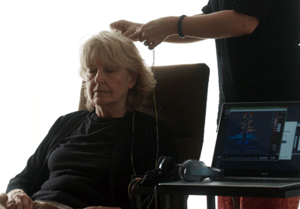
With linear neurofeedback, feedback is provided via cues in visual stimulus, like video games. For example, a spaceship will only move forward if the brain is exhibiting the Beta wave frequency. If the spaceship moves, this provides positive feedback that the brain is doing the right action. As the brain is rewarded, it learns to increase the production of that frequency.
The only non-linear neurofeedback system currently on the market is the NeurOptimal® system. The main difference between non-linear and linear neurofeedback, is that in non-linear feedback the trainee's brain, not the trainer, is the expert deciding what to do about the brain's maladaptive patterns.
The system mirrors the brain's natural functioning. It is designed using dynamical non-linear mathematics that mimics how the brain naturally uses feedback to improve itself. The key ingredient in brain science is that in order for the brain to function optimally, it needs real-time information about its own communication.
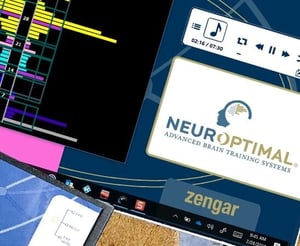 Brain training with NeurOptimal® essentially teaches the brain to be a better learner. The brain is being alerted to pay attention to its moment-to-moment choices at the speed of milliseconds. The software samples 256 data points per second, to check if the brain is shifting patterns.
Brain training with NeurOptimal® essentially teaches the brain to be a better learner. The brain is being alerted to pay attention to its moment-to-moment choices at the speed of milliseconds. The software samples 256 data points per second, to check if the brain is shifting patterns.
When those shifts happen, the software stops music that is playing during the session. The NeurOptimal® system uses auditory cues because that is the primary sense perception used by the brain to note changes in the environment. The reason being, we can hear even when we are sleeping. When the brain is alerted by the interruptions, it notices its habitual patterns. When patterns are noticed they can be assessed and corrections can be made.
Once your brain learns to use the present moment as its source of information, we start to notice qualitative changes. For example, the stress response (worry, irritability, anger outbursts, etc) is a strategy meant for resolving immediate threats to your body's safety.
When you brain train with neurofeedback, your brain begins to see that it is activating a stress response even when there is no danger present.
When it realizes that, your brain will start to shift out of that reactive pattern. You'll know your brain is learning because you start to calm down, cheer up, sleep better, react less strongly, and have greater mental clarity.
 Neurofeedback training helps us to shift the emotional response patterns that have become habits. A good analogy is when you are daydreaming and in a daydream you are not aware of what is happening, until the friend you're having coffee with says your name. You simultaneously realize that you were lost in a daydream and also take in information about the here-and-now. In the same way, NeurOptimal® uses musical cues to "say your name", and alert the brain that it is drifting.
Neurofeedback training helps us to shift the emotional response patterns that have become habits. A good analogy is when you are daydreaming and in a daydream you are not aware of what is happening, until the friend you're having coffee with says your name. You simultaneously realize that you were lost in a daydream and also take in information about the here-and-now. In the same way, NeurOptimal® uses musical cues to "say your name", and alert the brain that it is drifting.
The cues bring the brain back to reality. And because of the way the brain is designed, when it is alerted it will begin choose responses that are more in alignment with current needs. As a result, instead screaming or fixating with worry, you will speak firmly and acknowledge your concerns.
These devices are not technically neurofeedback because instead of offering cues through shifts in auditory or visual input, the are actually adding a very low electromagnetic stimulation to the brain. The goal is the same--to interrupt the maladaptive patterns-- but it is accomplished through adding a microcurrent to interrupt the electrical patterns of the brain.
This is the only device that adds something to the brain; linear and non-linear devices add nothing to the brain, but rather alert the brain to its natural patterns.
In the last few years, neurofeedback became popular for consumers interested in anti-aging, peak performance and optimization of wellness. This was in part because of recommendations by wellness guru, Dave Asprey.
 Lifestyle hacker and author, Dave Asprey, who created Bulletproof coffee and lifestyle brands, helped boost the educated public's awareness of neurofeedback eight years ago when he decided to "hack his own biology." He started trying various diet and wellness products to boost his health with the goal to live to be 180 years old. He created Bulletproof coffee, which is now sold in major grocery stores across the US--it is mixed with his brand of nutritional fat and is high in omega 3s. It is marketed as the ultimate brain fuel.
Lifestyle hacker and author, Dave Asprey, who created Bulletproof coffee and lifestyle brands, helped boost the educated public's awareness of neurofeedback eight years ago when he decided to "hack his own biology." He started trying various diet and wellness products to boost his health with the goal to live to be 180 years old. He created Bulletproof coffee, which is now sold in major grocery stores across the US--it is mixed with his brand of nutritional fat and is high in omega 3s. It is marketed as the ultimate brain fuel.
In his search for the ultimate brain training tools, he came across NeurOptimal® neurofeedback. He loved the results and shared "his best biohack yet" with his millions of followers on his podcast: Bulletproof Radio. He interviewed the co-creator of NeurOptimal on his show, Dr. Valdeane Brown. Listen to that interview here.
Dave's passion for neurofeedback helped launch it into greater public's awareness.
Let's start with the linear neurofeedback systems, which use clinician-set protocols to alert the brain to shift its activity away from patterns that are problematic and towards activity that matches normal patterning.
This type of neurofeedback may have some side effects if not administered by an experienced trainer, who is certified in using the technology. With protocol-based neurofeedback, it is not advised to see a trainer who is new to the field.
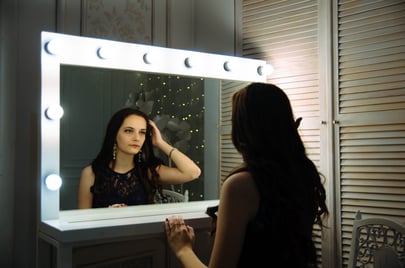 With non-linear neurofeedback equipment, it is hard to argue that any post-session experiences are side effects because nothing is added to the brain, nor is there any outside expert training the brain to increase or decrease any category of brainwave patterns.
With non-linear neurofeedback equipment, it is hard to argue that any post-session experiences are side effects because nothing is added to the brain, nor is there any outside expert training the brain to increase or decrease any category of brainwave patterns.
An analogy for the feedback process is seeing your reflection in a mirror. If you see your head is tilted, you will automatically straighten it. NeurOptimal® alerts the brain that it is doing something and each brain will decide how to use the information presented in order to optimize its own functioning.
The brain is actually designed to use its energy efficiently and effectively, but it doesn't always see that it is caught in a maladaptive habitual pattern. The training alerts the automatic brain to pay attention to itself at the exact millisecond that the brainwave patterns are occurring, thus giving the individual the opportunity to reset these habits.
Clients report more awareness of physical sensations and emotions. A common post-session experience with people who don't sleep enough is that they are tired. This is not a side effect. It is simply the result of becoming more aware of what is already there.
Increased awareness allows us to attend to the areas of life that need attention and to help find balance. For example, if you are ignoring the need for rest, and you become aware of your tiredness, you are more likely to go to bed earlier. That is a win-win for you and your brain.
 The system is designed to give the brain information about what it is doing, millisecond by millisecond. The brain then uses this data to organize itself and function in alignment with present needs, while utilizing the minimum energy necessary.
The system is designed to give the brain information about what it is doing, millisecond by millisecond. The brain then uses this data to organize itself and function in alignment with present needs, while utilizing the minimum energy necessary.
Put another way, the brain is given a map and can decide how to best improve its functioning and efficiency based on the information.
For example, the stress response is a huge waste of the brain's energy if the body is not currently in danger, and that is why neurofeedback shifts the brain's stress response levels.
Clients report feeling calmer and more relaxed after sessions.
During a session, the client listens to music. The music plays continuously when the brain is running “on course” (in alignment with present moment needs) but as soon as the neurofeedback system detects that the brain has “veered off” its path or has become less stable than it just was, feedback is provided to the brain via a micro-pause in the sound. Most of the pauses are consciously inaudible and noticed only by the automatic brain, which processes auditory information at a speed we don't consciously register.
We only notice the interruptions when 3 or 4 of them happen in rapid succession, and we hear it as a "record scratch" sound.
The pause acts as an interrupter of a habitual pattern, such as the stress response, which allows the automatic-functioning brain to notice how it is veering off course. By providing this information, the neurofeedback software gives the opportunity for the brain to adapt itself.
It is like you were used to using last week's weather report to decide what coat to wear and now someone just handed you today's weather report!
Natalie Baker has over 25 years of experience as a licensed psychotherapist and has been a NeurOptimal® neurofeedback trainer since 2011. She is the founder of Neurofeedback Training Co., which offers in-person sessions and runs the largest nationwide home rental program for NeurOptimal systems. Natalie also teaches meditation and Buddhist psychology and specializes in working with anxiety, stress, ADHD, and trauma.
How does neurofeedback work? Discover the science behind it and how it can benefit you. Learn more on our blog.
Is NeurOptimal® neurofeedback effective? Read reviews from neurofeedback trainers and their clients. Discover how they learned to worry less and...
Neurofeedback is an effective tool for dealing with performance anxiety and fear. Neurofeedback training is a safe way to train your brain and...
Be the first to know about new blogs